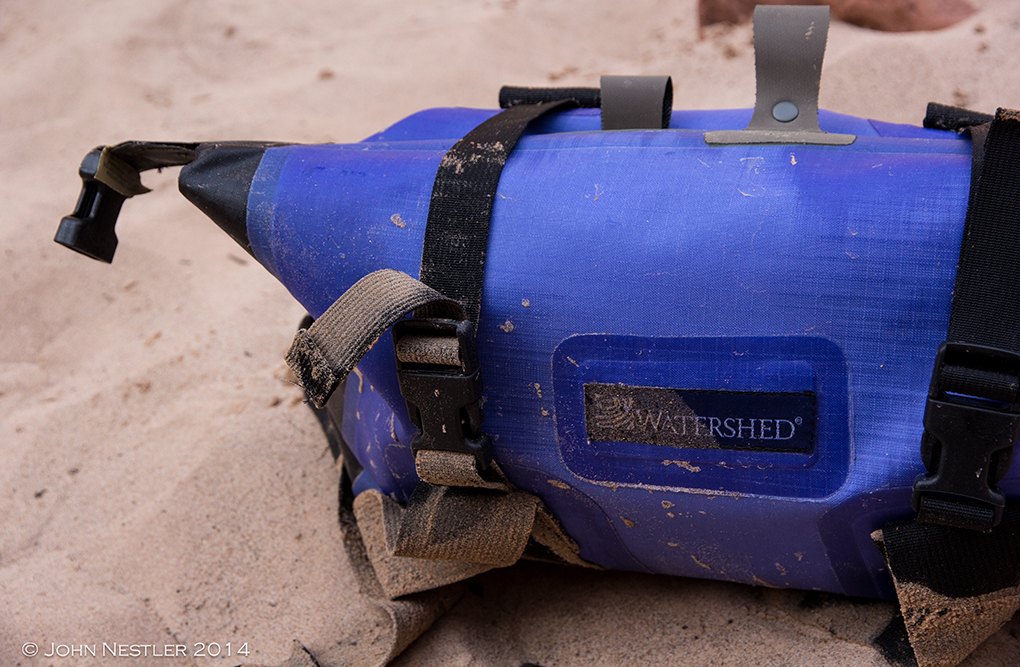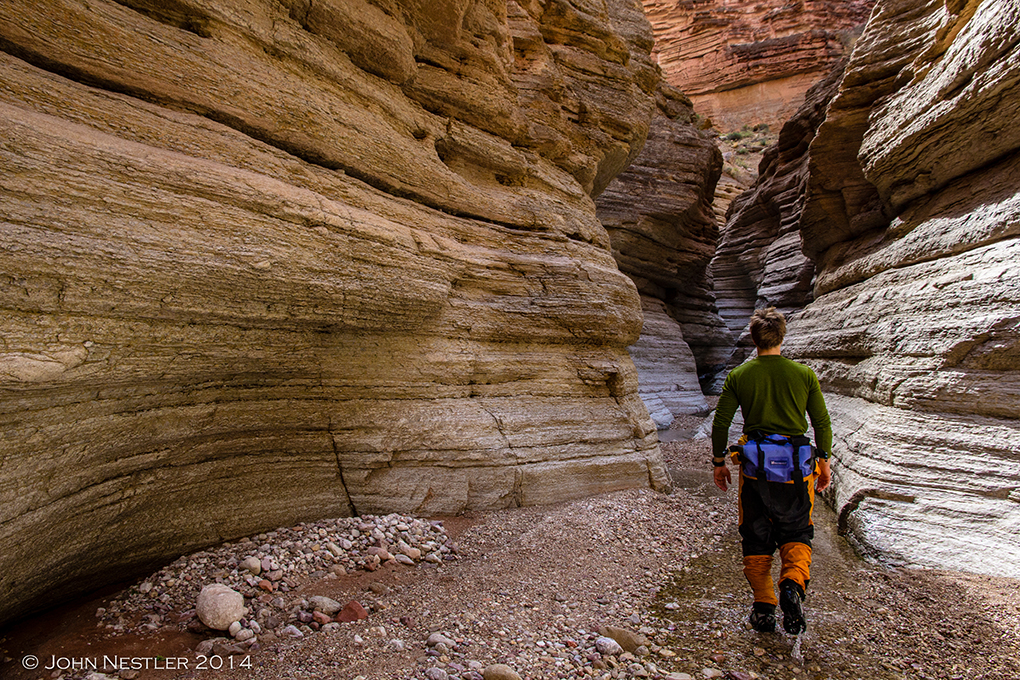
Watershed Go Forth Dry Bag
MSRP: $90
Capacity: 15L
Dimensions: 9″H x 16″L x 8″W
Opening Size: 13”
Days Tested: ~30
Locations Tested: Grand Canyon of the Colorado, Gore Canyon
The Watershed name is synonymous with quality drybags, and many boaters use them exclusively due to their bomber durability and proven dryness. Watershed’s Ocoee model is a convenient size for use as a day bag, and has gained popularity as a camera bag that has room for snacks and a layer or two.
The Ocoee features carrying straps for hand or shoulder carrying, but Watershed decided to increase the versatility of this dry bag by adding a removable webbing waist belt, enabling the bag to be worn as a fanny pack. This new variation of the Ocoee bag is called the Go Forth.
The Go Forth sounded very appealing to me as I packed for a 27 day, solo kayak trip down the Grand Canyon. Many popular side canyon hikes involve scrambling on steep slopes and boulders in narrow slot canyons, and I knew that the ability to keep my hands free to climb would be a crucial.
Dryness / Waterproofing
Few drybags on the market are completely dry on the inside when submerged for long periods of time. Watershed bags, however, have a reputation for keeping contents bone dry, and their patented ZipDry seal has been tested submerged in water up to 300’. I had no problems after submerging the Go Forth each morning in order to clean it of sand before loading up my boat.
Opening the Go Forth via Watershed’s ZipDry system takes a little getting used to, but a little practice pulling the bag’s tabs away from each other in an “S” fashion is all that’s needed to become familiar with the motion.

The bag’s flexible rubber closure does become difficult to use when in arid climates for extended periods, or if sand becomes lodged inside. Keeping the Go Forth’s closure system clean on extended trips is paramount, and frequent lubricating with 303 Protectant will ensure a tight, smooth seal. The factory lubrication wore out after 20 days in the Canyon, and it was noticeably harder to manipulate the seal at this point. I packed along a few 303 packets in anticipation of this, and had no issues with the closure on the Go Forth after re-applying 303 to the rubber tracks. And if you’re in a pinch, saliva will work to temporarily lubricate the closure.
Durability
The Go Forth is made with a new 420-denier Cordura, high-tensile plain weave nylon thread coated in layers of polyurethane to create a durable, flexible, strong material. The bag’s main body didn’t sustain any punctures or tears during my 27 days on the river, despite being thrown against sharp volcanic rock as I slid down cinder fields, lowered myself over boulders, and shimmied over drops.

If the material on your Watershed bag does happen to rip, a field fix can be done with duct tape and Aquaseal. (Watershed also performs in-house repairs; patch work and handle replacements can be done for $25.)
Carrying Comfort
I wanted to carry a DSLR, snacks, and a layer in the Go Forth while on the river or day hike, but this relatively heavy load proved to be too heavy to carry comfortably while wearing the bag around my waist. The bag sits on my waist more comfortably when carry a lighter load made up of a spare layer, snacks/light lunch, and a smaller camera.
The webbing waist belt connects to the bag by passing through two loops. Unfortunately, these loops are located relatively low on the bag. The result of this is that a significant load will cause the bag to tilt away from the user and bounce around while walking or running. This can be avoided to a small degree by packing heavier objects in the middle of the bag, but it is difficult to maintain this balanced packing as items shift around.
The Go Forth’s waist belt isn’t padded, which unfortunately means that it can cause some chafing, even when carrying a load that isn’t too heavy. The waist belt also tended to fold in on itself, causing the webbing to cut into my side more than it would have if it were to remain flat. I would like to see Watershed add some padding to the strap to make it more comfortable and to help distribute the weight more evenly around the hips.
Finally, only one side of the waist belt has an adjustable length, and the belt slides freely through two attachment loops on the bag. This makes it a bit difficult to put the bag on without it sliding side-to-side on the waist belt, which is an issue because if you let go of one end of the belt when unbuckling the bag, it can slide off the belt entirely. When fastened, the belt’s buckle system was very secure and easily adjustable, but its total length was overly generous for my 32” waist. After cinching it down snugly, I was left with about 2 feet of extra webbing material.

Carrying Functionality
Aside from the drawbacks mentioned above, the Go Forth worked well as a fanny pack on long day hikes. I was still able to carry a heavy load in the bag throughout the day. Most important, my arms were freed up and relieved of the stress of carrying a day bag, and I could also be assured that the contents would be dry in a rainstorm or if the bag was submerged. Having my hands free also allowed me to climb up and into narrow slot canyons which would have been much more difficult if I had clipped the bag to me with a carabiner.
Recently I used the Go Forth while running a strenuous 9-mile bike shuttle for an early season Gore Canyon lap. The bag protected my bike repair kit from mud and transformed beautifully into a standard dry bag for my camera and snacks when I arrived at the put-in. The small load of a bike repair kit, shirt, and snack was light enough that the bag was very comfortable and stable to use as a fanny pack.
I always carry a water bottle on excursions, and the Go Forth lacks a water bottle holder. I ended up adding a strap to the bottle and clipping it into the bag with a carabiner. I hesitate to put a water bottle into a the dry bag, for obvious reasons, and I’d like to see Watershed add a simple water bottle holder to the bag.
Bottom Line
Watershed took a very popular dry bag and increased its versatility by adding a minimalist waist belt. The belt certainly works, but it could be more comfortable when it came to carrying heavier loads. There’s a lot of room for improvement with the Go Forth as it functions as a fanny pack, and hopefully Watershed will address some of those issues in the future.
That being said, the Go Forth was still the most useful piece of gear I took with my on my Grand Canyon trip. It worked as an outstanding dry bag while on the river, and I was able to climb up and into slots with my camera, tripod, water, and day hiking essentials while on 6-8 mile day hikes. Ultimately the added fanny pack functionality of the dry bag let me travel more efficiently while keeping my camera gear safe and dry.
